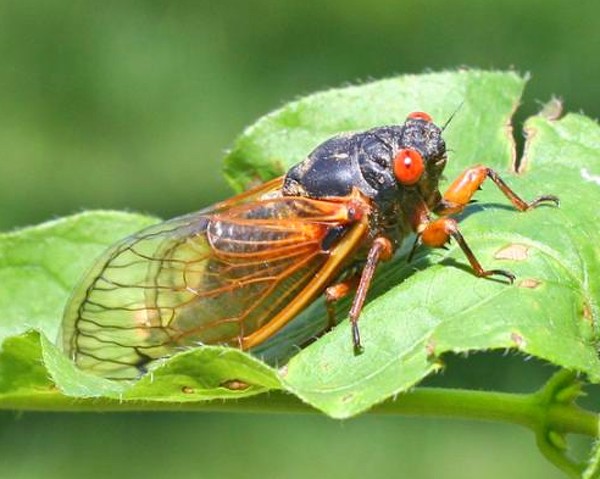Wednesday, April 28th, 2021
Noisy, ugly insects make their return
Brood X cicadas appear every 17 years
By Leslie Gartrell

Submitted Photo
Brood X cicadas are expected to emerge the first week in May. Joe Boggs, Ohio State University Extension.
What's that sound? Is it a bird? Is it a plane?
No, it's Brood X!
The Brood X Cicadas, a type of cicada that only emerges every 17 years, are estimated to make their noisy return around the first week of May.
Ohio Department of Agriculture plant health expert Audra Sabo said the big, bumbling bugs are actually periodical cicadas. The term "brood" is applied to the massive synchronous appearances of periodical cicadas, and Roman numerals are used to define both the year and the geographical distribution of each emergence, according to an article by Ohio State University Extension educator Joe Boggs.
Sabo said Brood X is the tenth periodical cicada cohort entomologists have studied over the years, which is where the brood gets its name. ODA officials expect to see the largest concentrations of Brood X in Defiance, Franklin, Greene, Hamilton, Logan and Montgomery counties. However, Sabo said Mercer and Auglaize county residents likely could still see them in May and June.
The brood is is one of the largest based on geographical distribution, according to Boggs. The group will rise from beneath deciduous trees in parts of Ohio and in Delaware, Georgia, Illinois, Indiana, Kentucky, Maryland, Michigan, North Carolina, New Jersey, New York, Pennsylvania, Tennessee, Virginia, West Virginia and Washington, D.C.
Brood X cicadas typically have black bodies, orange wing veins, red eyes and six legs, according to ODA. They are usually one to two inches long, with a three-inch wingspan. While they may be big, Sabo said the bugs are harmless and will try their best to mind their own business.
However, cicadas are clumsy fliers. If they bump into a human, it's most likely an accident, Sabo said, so brush them aside.
The periodical cicadas get their start in trees. Female cicadas insert their eggs through the bark and into the wood of small branches and twigs, Sabo said. The resulting damage splits the bark and wood and eventually causes the stems to die, detach and drop to the ground.
Once on the ground, the young cicadas, called nymphs, migrate toward the tree roots where they use their piercing-sucking mouthparts to tap into the roots for the next 17 years.
Sabo said while it may sound like a bad deal for the trees, the relationship is mutually beneficial. Feeding activity has never been shown to cause significant harm to overall tree health.
The bugs grow under ground, Sabo said. Underground, the nymphs can eat as much as they want without the threat of predators and emerge well-fed, eliminating the need to feed above ground.
After the cicadas emerge, they shed their nymphal exoskeleton. Once they can fly, the fun begins. Sabo said male cicadas have two structures on their abdomens behind the wings called tymbals to produce their own "music."
The cicada uses strong muscles inside their bodies to pull the tymbals inward causing the ribs to buckle, which makes a sharp snapping sound, according to Boggs. Another sound is made when the muscles relax causing the tymbals to snap back. The cicada repeats this action 300 to 400 times per second to create a vibrato drone.
The sound has been measured at more than 100 decibels, Sabo said, which is equivalent to a motorcycle, low-flying plane or lawn mower starting. The sound of a group of cicadas is often compared to the sound of electricity, according to ODA.
Sabo said when males make the noise together it's called a "choir," which can be heard up to an hour and a half away from where the brood is located. Of course, female cicadas love a good song, so a pair will mate and start the 17-year process all over again.
Sabo emphasized that the cicadas are not tree or plant killers. Boggs in his OSU Extension article said the cicadas' focus on the tips of branches and twigs translates into a form of natural pruning.
"We know that they make up for the small amount of damage caused to their host trees by stimulating fuller canopies through tip-pruning," he wrote.
The cicadas also help with new root development by aerating the soil when they emerge, and their decaying bodies return nutrients to the trees, Sabo said. They also are eaten by a wide variety of animals, such as raccoons, birds and even bears.
"It's really helpful to our wildlife," Sabo said. "It's an extra source of food for them and it's helpful to the soil, as well, when these broods emerge."
Brood X is a big one - billions of them are anticipated to scratch their way to the surface. Sabo said cicadas appear in huge numbers as a way to overwhelm predators in a survival strategy called "predator satiation." The sheer number of cicadas overwhelm even the most gluttonous predators, leaving large numbers to reproduce and ensure their survival.
Sabo said there are a few things to keep in mind once the brood emerges. Periodical cicadas won't cause damage to homes, gardens, crops, animals or mature trees, but homeowners may want to consider shrouding a new tree in a mesh net.
However, Boggs in his OSU Extension article noted cicadas don't stray far from the trees from which they developed, so homeowners may want to delay netting until they see the cicadas.
As the cicadas emerge, domestic pets like dogs and cats may want to snack on the bugs, which Sabo said are high in protein. People should keep an eye on their pets to make sure they don't overindulge and risk a visit to the vet. Cicadas will not sting or bite, and they are not poisonous to animals, according to ODA.
Sabo said while a lot is known about periodical cicadas, the exact geographical distribution of Brood X is important. Cicada populations are often highly localized with large concentrations commonly near areas with no cicadas, according to Boggs, so it's important for future predictions to better define where they may or may not be seen.
Researchers have created an easy-to-use smartphone mapping app called Cicada Safari. Observers can photograph Brood X and submit their pictures through the free app so researchers can confirm the sightings and add them to the cicada map.
Sabo said people also can track the brood by using the hashtag #BroodX and help researchers record data.




